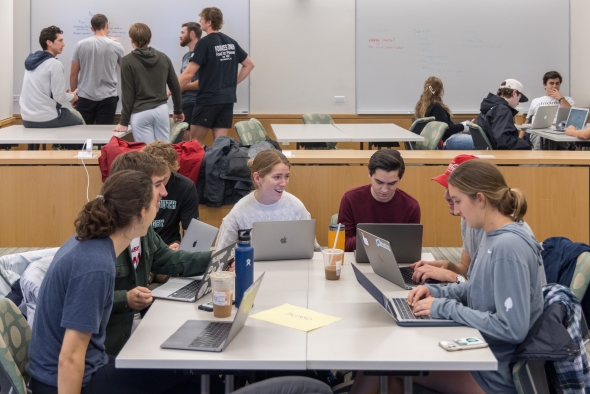
Menu
- About
- Departments & Programs
- Faculty Resources
- Governance
- Diversity
- News
Back to Top Nav
Back to Top Nav
Back to Top Nav
Back to Top Nav
As interest in the humanities among undergraduates nationwide wanes, professor Tania Convertini challenges fellow educators to look beyond course content to ask: "How does innovation in format help bring students on board?"
When professor Tania Convertini realized that nearly 80 students had registered for her course "Journey to Italy: An Introduction to Italian Culture" this fall—a record-breaking enrollment—she was determined to maintain the course's popular balance of readings, discussion, and hands-on activities.
A research assistant professor in the Department of French and Italian, Convertini directs the Italian language program at Dartmouth and researches and writes about media studies, film, and language pedagogy. Drawing on her expertise in multimodal learning and the use of technology in the classroom, Convertini designed this fall's "Journey to Italy" to give as much agency to students as possible, opening the door for them to forge meaningful connections with Italian culture and one another.
First launched in 2019, "Journey to Italy" encourages students to think critically about notions of culture and identity. Topics include stereotypes and national identity, modern history, society and politics, food culture, the visual arts, music, cinema, religion, science and technology, the environment, sports, and immigration. The course typically brings together first-year students who are considering a major in Italian with juniors and seniors who have the time to take classes that pique their interests.
Two undergraduate students who took the course last year serve as teaching assistants, and Convertini also works closely with her graduate student teaching assistant, Agnese Palumbo.
As interest in the humanities among undergraduates nationwide wanes, Convertini challenges fellow educators in the liberal arts to look beyond course content to ask: "How does innovation in format help bring students on board?"
New Technologies Extend the Class Community
Convertini champions integrating new technology into the learning environment. This fall "Journey to Italy" includes an original weekly podcast that she records and publishes herself.
"Well-being is so important for our students, and I love that a podcast enables them to think about course material in a flexible way—at the gym, on their way to class, or on a walk," Convertini says. "We can jumpstart the discussion wherever they are."
Each five-minute podcast introduces upcoming themes and concludes with a question for future discussion.
In addition to posting class assignments and information on Canvas, Convertini fosters informal discussions about key themes through a class text messaging group via GroupMe. "Students will frequently share a photo or idea that came to them after class, which is just great," Convertini says. "Every time coursework becomes an opportunity for conversation in students' day-to-day activities, we are entering their intellectual lives in ways that extend beyond the classroom."
"Having that richer context on the material that we engage with outside of class has really helped me think about course themes," says Will Glovsky '23. "It's evident that Professor Convertini really cares about our learning."

Student Learning at the Center of Course Design
Convertini designed the course with myriad pathways where students make connections with the coursework and one another. Small groups of six or seven students meet weekly on their own to discuss material, with Convertini and her teaching assistants dropping in on groups on a rotating basis. "These clusters create a small community of people working together," Convertini says.
Working closely with the Registrar's Office, Convertini chose a customizable classroom space that fosters interaction and collaboration, with chairs and tables easily rearranged.
"Professor Convertini does an excellent job of creating a simultaneously rigorous yet low-stress environment where we're encouraged to take creative risks within the safe environment of our small discussion groups," says Celeste Graham '23.
All the groups gather together for class on Wednesdays and Fridays, where Convertini has each student submit "QQTPs" in advance—a question for discussion, a compelling quote from the assigned reading, and a few talking points in response to a question she relays to students through her 5-minute weekly podcast.
Each Friday students take part in a live Q&A with a leading Italian cultural figure who joins them in person or via Zoom—such as Roman hip-hop artist Amir Issaa, who spoke with students about countering racism through rap, and Soledad Twombly, a renowned Italian designer "whose classic yet unique style was visible even on a Zoom screen," says Graham.
Additionally, Convertini works closely with academic curators at the Hood Museum of Art to connect students with material objects and art that relate to the course. On Nov. 14, between 5 and 7 p.m., each cluster will present a public analysis of select items based on a theme from the course.
Ultimately, Convertini hopes students leave "Journey to Italy" with a new understanding of how cultural values inform and inspire the world around them. "When we start to understand the role of culture in education and history," she says, "we gain a better intercultural understanding of who we are."